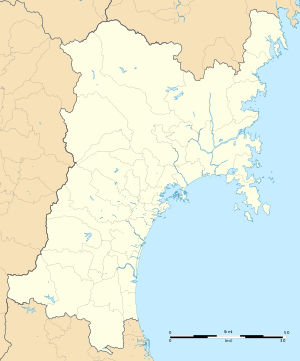Sendai Tōshōgū
Sendai Tōshōgū (仙台東照宮) is the memorial shrine of Tokugawa Ieyasu in Sendai, Miyagi Prefecture, Japan. Five of its buildings, all dating to 1654, have been designated Important Cultural Properties.[1] The torii and gates were damaged in the 2011 Tōhoku earthquake and tsunami.[2]
| Sendai Tōshōgū 仙台東照宮 | |
|---|---|
 Torii on the approach to Sendai Tōshōgū | |
| Religion | |
| Affiliation | Shinto |
| Deity | Tokugawa Ieyasu |
| Festival | April 14 |
| Type | Tōshō-gū |
| Location | |
| Location | 1-6-1 Tōshōgū, Aoba-ku, Sendai, Miyagi |
 Shown within Miyagi Prefecture  Sendai Tōshōgū (Japan) | |
| Geographic coordinates | 38°16′49″N 140°53′06″E |
| Architecture | |
| Style | Irimoya-zukuri |
| Founder | Date Tadamune |
| Date established | 1654 |
| Website | |
| www | |
History
The Sendai Tōshōgū was established by Date Tadamune, the second daimyō of Sendai Domain. Construction began in August 1649, and was completed in March 1654. The shrine served as the tutelary temple of the Date clan during the Edo period. However, with the fall of the Tokugawa shogunate in 1868, the new Meiji government initially closed the shrine. It was soon re-opened due to demands of local townspeople, and under the State Shinto system of shrine ranking from 1879 through 1916, was officially designated as a "county shrine" and from 1916 to 1946 as a "prefectural shrine".
Notable structures
- Honden (本殿) (1654) (Important Cultural Property)[3]
- Karamon (唐門) (1654) (ICP)[4]
- Sukibei (fence) (透塀) (1654) (ICP)[5]
- Zuijinmon (透塀) (1654) (ICP)[6]
- Torii (鳥居) (1654) (ICP)[7]
See also
- Tōshō-gū
- List of Tōshō-gū
- Nikkō Tōshōgū
- Zuihōden
- Entsū-in
- List of Shinto shrines
References
- "Cultural Properties". Sendai Tōshō-gū. Archived from the original on 12 January 2011. Retrieved 6 May 2011.
- "岡倉天心ゆかりの文化財「六角堂」、津波で消失". Daily Yomiuri. 12 March 2011. Retrieved 6 May 2011.
- "Database of Nationally-Designated Cultural Properties etc". Agency for Cultural Affairs. Archived from the original on 23 December 2019. Retrieved 25 March 2011.
- "Database of Nationally-Designated Cultural Properties etc". Agency for Cultural Affairs. Archived from the original on 23 December 2019. Retrieved 25 March 2011.
- "Database of Nationally-Designated Cultural Properties etc". Agency for Cultural Affairs. Archived from the original on 23 December 2019. Retrieved 25 March 2011.
- "Database of Nationally-Designated Cultural Properties etc". Agency for Cultural Affairs. Archived from the original on 23 December 2019. Retrieved 25 March 2011.
- "Database of Nationally-Designated Cultural Properties etc". Agency for Cultural Affairs. Archived from the original on 23 December 2019. Retrieved 25 March 2011.
External links
| Wikimedia Commons has media related to Sendai Tōshō-gū. |
(in Japanese) Official website